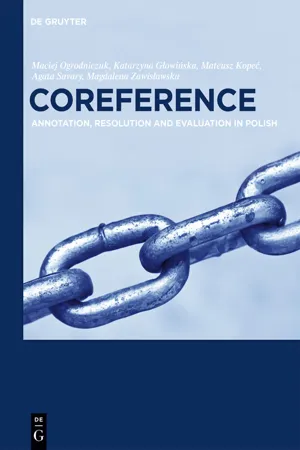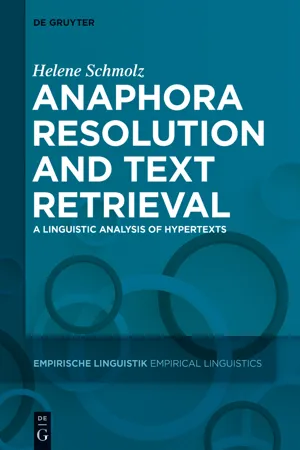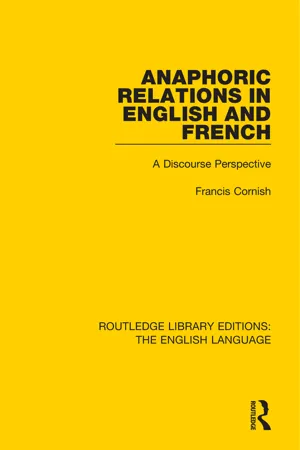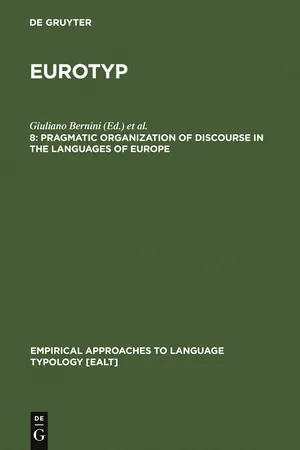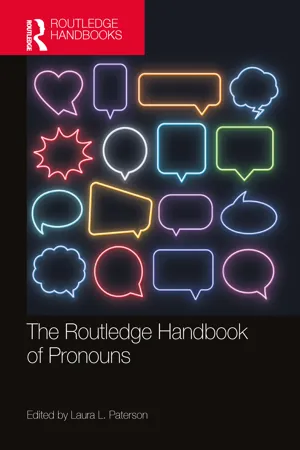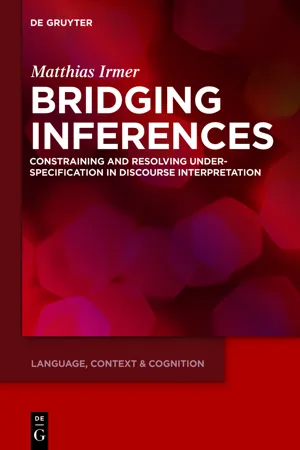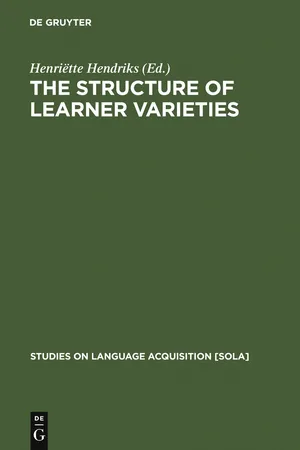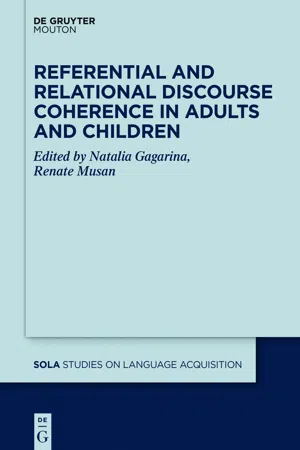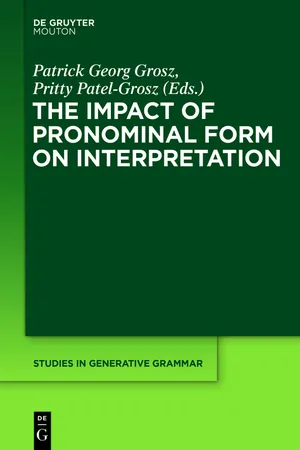Languages & Linguistics
Anaphoric Reference
Anaphoric reference is a linguistic phenomenon where a word or phrase refers back to a previously mentioned word or phrase. It is used to avoid repetition and maintain coherence in discourse. Anaphoric references are common in many languages and play a crucial role in understanding and interpreting written and spoken communication.
Written by Perlego with AI-assistance
10 Key excerpts on "Anaphoric Reference"
- eBook - ePub
Coreference
Annotation, Resolution and Evaluation in Polish
- Maciej Ogrodniczuk, Katarzyna Glowinska, Mateusz Kopec, Agata Savary, Magdalena Zawislawska(Authors)
- 2014(Publication Date)
- De Gruyter(Publisher)
On the textual level, anaphora is treated as a means of reintegration of the series of sentences, following the semantic convention accepted by the receiver of the text. Lack of such linguistic means as anaphoric pronouns can lead to difficulties in maintenance of the inter-utterance relation. Pisarkowa also shows an interesting distributional difference of use of pronouns and their nominal counterparts in a text: when, particularly in longer passages, which, naturally, contain a larger number of nominal elements, the traditional means of identity disambiguation (called “flexion abilities”) fail to work, full nounal denominations need to be repeated for clarity. What is more, such repetition needs neutralization of the full mark by addition of the demonstrative pronoun (such as ten, ta, to ‘this’) or by use of synonym to denote that the designate is not “new”, but already known from the context. 2.2.2 Bellert Bellert (1971) introduces the notion of language indices (presently: mentions) as a common name for textual connectors such as nouns, nominal groups, named entities, personal, relative or reflexive pronouns or certain adverbs (here, there) serving as referential expressions in discourse. 2.2.3 Wajszczuk Wajszczuk (1978) treats binding as a concept deriving from a much broader theory of textual coherence, and investigates relevance and entailment of subsequent utterances in the process of development of consistent discourse - eBook - ePub
Anaphora Resolution and Text Retrieval
A Linguistic Analysis of Hypertexts
- Helene Schmolz(Author)
- 2015(Publication Date)
- De Gruyter(Publisher)
the big box and the small one, these boxes and the ones in the kitchen […]). (ibid.: 265-266)As for derivations, the adjective anaphoric and the adverb anaphorically are first mentioned in 1914 (cf. Bloomfield 1984: 249-251; Simpson & Weiner 1989: 436-437). According to the Oxford Dictionary of English (2005, 2nd rev. ed.), the noun anaphor has its origin in a backformation of anaphora , which dates back to the 1970s (cf. Soanes & Stevenson 2005: 55).When consulting current dictionaries, the word anaphora often divides up into different senses, depending on its use in various contexts. First, the term denotes a part of the mass in liturgics. Second, “anaphora” describes the “repetition of a word or phrase at the beginning of successive clauses, lines of verse, etc.” (Agnes et al. 2007: 51) in rhetoric (cf. Wilpert 2001: 27). So it is still used in the sense it was for the first time (cf. Puttenham 1589, above). Third, “anaphora” is used in music for the repetition of a voice, usually the bass (cf. Bartel 2007: 90-95).The fourth – grammatical – definition is of importance here: “anaphora” is “[t]he use of a word which refers to, or is a substitute for, a preceding word or group of words” (Simpson & Weiner 1989: 436). According to Valentin (1996: 179), this meaning has developed from the use of anaphora in rhetoric. The following example illustrates what an anaphor is in the grammatical sense of the word:- (1) Susan plays the piano. She likes music.1
In example (1), the word she is an anaphor2 and refers back to a preceding expression, in this case Susan . As can be seen in this example, an anaphor is an item that commonly points backwards.3 Anaphors derive their interpretation from the expressions they refer to because their own meaning is often rather general (cf. Finch 2005: 199-200; Trask & Stockwell 2007: 16-17; Huddleston 2010a: 68; Quirk et al. 2012: 335, 862). This becomes obvious if the second sentence in example (1), She likes music , appears on its own. In such circumstances, it is not possible to find out the person meant by she . We can only state that it is most likely a female person.4 But if both sentences are present, she is undoubtedly used in place of Susan - eBook - ePub
Introduction to Psycholinguistics
Understanding Language Science
- Matthew J. Traxler(Author)
- 2011(Publication Date)
- Wiley-Blackwell(Publisher)
We use explicit proper name anaphors to pick out either very weakly activated antecedents or to select from among a set of more than one highly activated antecedents. If we use an explicit form when there is only one highly activated possible referent, the listener might wonder why we are providing more information than required (a violation of the Gricean maxim of quantity). Alternatively, the listener may assume that the repeated name refers to a new discourse entity and therefore take extra time to set up a new token for that new entity. Further, because the new and old tokens have the same name (e.g., Steve), the listener will have difficulty keeping the two representations separate (leading to similarity based interference, e.g., Gordon, Hendrick, & Johnson, 2001). Binding Theory The relative positions of referents and anaphors in a syntactic structure interact with specific anaphor forms to determine whether an anaphor can refer to a specific previously introduced entity. One linguistic theory that seeks to explain how different kinds of anaphors can refer to particular antecedents in particular syntactic positions is binding theory (Chomsky, 1981, 1986; see Gordon & Hendrick, 1997, 1998 for very readable descriptions of the theory). Chomsky divides anaphors into three categories, which correspond to regular pronouns such as he, she, him, and her, reflexive pronouns such as himself and herself, and R-expressions, which include proper names. He suggests that different types of anaphors 12 are in complementary distribution, where distribution is defined across syntactic positions in sentences. For example, reflexive pronouns like himself and herself must pick out an antecedent that is in the same clause of the sentence - eBook - ePub
Anaphoric Relations in English and French
A Discourse Perspective
- Francis Cornish(Author)
- 2015(Publication Date)
- Routledge(Publisher)
ϕ here establishes, on the basis of its containing predication, a new discourse referent in terms of an already existing one; at the same time, the anaphor represents a new sub-topic (cf. Hannay, 1985) and introduces a new (but accessible) domain of reference whose relation to the immediately preceding one is (arguably) that of Reichman's (1978) 'Sub-Issue' Relation. Thus, yet again we have an instance where the situation is more complex and more subtle than standard theoretical accounts assume. Only by taking into account the full discourse context can the nature of the anaphoric relationship be properly specified.5.2.1 Linguistic reflexes of discourse referentsIt is Webber (1979) which, to my knowledge, provides the most extensive formulation of linguistic reflexes of discourse referents ('invoking/prior descriptions for discourse entities', in her terminology). The formulation of 'invoking descriptions' (IDs) is effected in terms of a version of the predicate calculus, involving restricted quantification (see 3.1.3, pp. 57-58 above). In her system, each sentence from the incoming discourse (as well as each clause, within a multi-clause sentence) is tagged with a number indicating its sequential position in the text, and is provided with a surface-syntactic parsing, following Jackendoff's (1977) X̄ notation system. This then constitutes the input to a preliminary semantic interpretation, termed 'Level 1 representation' (1979:Ch.2,27,61). This representation makes explicit the semantic information derivable from the surface structure parse tree (e.g. the possible scopes of any quantifiers present) and from the lexicon (e.g. the function-argument structure, functional case structure, and the selection restrictions imposed on the associated arguments, of the verbs present), as well as the mapping between function-argument structure and syntactic structure. Any anaphoric expressions present in the parse tree (e.g. personal pronouns, ellipsed predicates, 'description-substitutes') remain unresolved in the Level 1 representation. It is the 'Level 2 representation' which purports to capture the dynamic nature of discourse, and it is from this level of semantic representation that 'textually-evoked' IDs are formed. Here, any ambiguous scopes of quantifiers are resolved; unresolved definite third person pronouns are checked to see whether their most likely interpretation is in terms of a discourse referent, a bound variable, or a 'parameterized' entity (a local discourse referent (cf. Karttunen's 1976 'short-term' discourse referents) which is 'parameterized' by a variable, itself bound by a quantifier bearing wide scope); in the first and third of these cases, the pronoun in question is replaced by its corresponding discourse entity name ('e1 ', 'e2 - Giuliano Bernini, Marcia L. Schwartz, Giuliano Bernini, Marcia L. Schwartz(Authors)
- 2011(Publication Date)
- De Gruyter Mouton(Publisher)
If there is a clear-cut difference between performing intratextual deixis on the one hand and anaphora on the other, this will have to manifest itself in a thorough examination of the way in which the various expression means are actually employed in a specific language (see, for instance, the section on Romani below). For the moment, therefore, it seems best to look at the two notions as form-ing a continuum rather than a sharp distinction between basically different functions or actions of the speaker. Intratextual reference, including anaphora, may concern two semantically differ-ent types of entities. It may concern either items which are explicit constituents of some preceding clause (commonly first or second order entities: animate and inan-imate participants, events, and so on), or the reference may be to the content of a preceding clause or of a larger discourse segment as a whole (that is, to second, third, or even higher order entities, such as predications, propositions, paragraphs and episodes, etc.). Such reference is sometimes alluded to as “indirect anaphora.” 1 This semantic distinction between the types of entity referred back to may be rel-evant for describing the division of labor of pronominal expressions in a language, since languages may consistently select different pronominal expressions for the two types. Languages also differ in the range of expression means available for intratextual deixis and anaphora, and in the variability which they allow given the range of avail-able expressions. Some languages, such as Classical Latin (see Section 3), may just leave out explicit mention of the element concerned altogether (zero expression) in certain circumstances, or they may possess specific pronouns especially reserved for reference to the most highly accessible entities, distinct from the demonstrative pronouns which may also serve an extratextual deictic function.- eBook - ePub
- Laura L. Paterson(Author)
- 2023(Publication Date)
- Routledge(Publisher)
Research on the L1 acquisition of pronouns so far has strongly focused on personal pronouns (e.g., I, you, she, him) and reflexive pronouns (e.g., myself, herself). Within the category of personal and reflexive pronouns, an important distinction is between deictic and anaphoric pronouns, which relates to the way the pronouns are interpreted. Whereas anaphoric pronouns refer to a referent in the linguistic discourse, deictic pronouns refer to a referent that is present in the conversational setting, such as the speaker or the addressee. First- and second-person pronouns such as I and you typically receive a deictic interpretation. Third-person pronouns such as she and him are usually interpreted anaphorically, but can also be interpreted deictically in specific situations. A further distinction that is relevant for this chapter is the grammatical function of the pronoun, for example, whether it appears as the subject or as an object. In many languages, grammatical function is marked by case (e.g., nominative she versus accusative her in English) and determines the role of the referent in the event expressed by the sentence, for example whether the referent is an agent or a patient. This chapter starts with a brief discussion of the emergence of pronouns in early child language. Because the L1 acquisition of pronouns has been mostly studied in Indo-European languages, in particular English but also other Germanic languages, such as Dutch, and Romance languages, such as Italian, most examples in this chapter are taken from these languages. Next, three topics are discussed that are central to research on the L1 acquisition of pronouns: (1) pronoun reversals with deictic pronouns, (2) the Delay of Principle B Effect with anaphoric object pronouns, and (3) the referential choice regarding anaphoric subjects in discourse. Finally, several commonly used methods to study pronoun acquisition are briefly discussed, followed by some directions for future research. 2 - eBook - PDF
Bridging Inferences
Constraining and Resolving Underspecification in Discourse Interpretation
- Matthias Irmer(Author)
- 2011(Publication Date)
- De Gruyter(Publisher)
The es- sential reason for assuming discourse referents in the first place is that they can serve as antecedents for discourse anaphora. Consequently, I have tried to shed some light on the numerous notions used to explain why some discourse referents are better antecedents than others. We have seen that the availability of referents for Anaphoric Reference can be modelled in terms of focus, familiarity, givenness, accessibility, or salience. None of these concepts gives a thoroughly satisfying account of Anaphoric Reference. A theory which wants to account for discourse interpretation and, as a consequence, for anaphora resolution, can rely on any of these notions, although, obviously, it must go further and take additional considerations into account. 3.4 Theories of Anaphora Resolution This section presents theories of anaphora resolution from different points of view. First, I will briefly describe pragmatic constraints in in a neo-Gricean framework. Then, I will review accounts rooted in com- putational linguistics. I will sketch Sidner’s Focus Theory and describe its successor Centering Theory. Finally, I will close this section and the chapter with an introduction to Discourse Representation Theory (DRT), emphasizing on the treatment of anaphora in this theory. 104 3 The Discourse Model and Discourse Anaphora 3.4.1 A Pragmatic Account A pragmatic account of anaphora interpretation in a neo-Gricean framework (cf. section 1.1.2.2) was presented by Huang (1994). His the- ory of anaphora starts from the assumption that anaphora interpreta- tion can be explained by a small number of general pragmatic interpre- tation principles, which are expressed as a combination of neo-Gricean conversational maxims. These principles have to be further constrained by a set of consistency constraints which organize their interaction. - eBook - PDF
- Henriëtte Hendriks(Author)
- 2011(Publication Date)
- De Gruyter Mouton(Publisher)
Furthermore it must be said that use of referential forms is both intertwined with children's development of narrative discourse compe-tence (cf. Berman and Slobin 1994) 9 , which in adult learners should be already there (at least for LI), and affected by the system of devices that is avail-able/preferred in the language they are acquiring 10 . In conclusion, LI data show a complex (and not always coherent) picture, with a clear developmental progression from deictical referential devices to anaphoric ones; from relying on the nonlinguistic context to resorting to dis-course· internal referring expressions; from a general tendency to distinguish given from new referents (often on the speaker's knowledge basis) to the ac-quisition of language-specific local and (then) global devices for marking such a distinction; contributing more and more to textual cohesion in a language specific way. Various semantic, pragmatic and formal factors seem to affect the acquisition of referential means in the first language. Reference to person in learner discourse 71 2.3. The acquisition of language specific rules in L2 In L2 acquisition (where cognitive difficulties should be lower) the tendency to distinguish new referents from old ones comes earlier than in LI, but the means employed by learners are not always (morphologically) correct, al-though often pragmatically appropriate (Hendriks 1998). Apart from deictic means and gestures, in early varieties reference is often made with bare nouns and names, or is left implicit, to be inferred from the context. Early varieties typically lack articles, an important means to distinguish definite NPs from indefinite ones; some anaphoric (and, of course, deictic) pronouns are present, but overextended (i.e. he in English L2, sie in German L2). - Natalia Gagarina, Renate Musan, Natalia Gagarina, Renate Musan(Authors)
- 2020(Publication Date)
- De Gruyter Mouton(Publisher)
Consten, M. 2004. Anaphorisch oder deiktisch? Zu einem integrativen Modell domänengebundener Referenz. Tübingen: Niemeyer.Cooper, R. M. 1974. The control of eye fixation by the meaning of spoken language. A new methodology for the real-time investigation of speech perception, memory and language processing. In Cognitive psychology 6, 84–107.Crawley, R. A., Stevenson, R. J., Kleinman, D. 1990. The use of heuristic strategies in the interpretation of pronouns. In Journal of Psycholinguistic Research 19 (4), 245–264.Dussias, P. E., Valdés Kroff, J. R., Guzzardo Tamargo, R. E., Gerfen, C. 2013. When gender and looking go hand in hand. Grammatical Gender Processing in L2 Spanish. In Studies in Second Language Acquisition 35 (2), 353–387.Ehrlich, K. 1980. Comprehension of pronouns. In Quarterly Journal of Experimental Psychology , 32 (2), 247–255.Ellert, M. 2010. Ambiguous Pronoun Resolution in L1 and L2 German and Dutch. In MPI Series in Psycholinguistics 58. Wageningen: Ponsen and Looijen.Ellert, M., Roberts, L., Järvikivi, J. 2011. Verarbeitung und Disambiguierung pronominaler Referenz in der Fremdsprache Deutsch: Eine psycholinguistische Studie. In Krafft, A. and Spiegel, C. (eds.): Sprachliche Förderung und Weiterbildung-Transdisziplinär. Frankfurt am Main: Peter Lang, 51–68.Frederiksen, J. R. 1981. Understanding anaphora: Rules used by readers in assigning pronominal referents. In Discourse processes 4, 323–347.Gagarina, N. 2007. The hare hugs the rabbit. He is white...Who is white? Pronominal anaphora in Russian. In ZAS Papers in Linguistics 48, 133–149.Gernsbacher, M. A., Hargreaves, D. J. 1988. Accessing sentence participants: The advantage of first mention. In Journal of Memory and Language 27 (6), 699–717.Givón, T. 1983. Topic continuity in discourse: An introduction. In Givón, T. (ed.): Topic continuity in discourse: A quantitative cross-language stud., Amsterdam: John Benjamins Publishing, 1–42. Gordon, P. C., Grosz, B. J., Gilliom, L. A. 1993. Pronouns, names, and the centering of attention in discourse Cognitive Science 17, 311–347.- eBook - ePub
- Patrick Grosz, Pritty Patel-Grosz, Patrick Grosz, Pritty Patel-Grosz(Authors)
- 2016(Publication Date)
- De Gruyter Mouton(Publisher)
Anaphora and semantic interpretation . London: Croom Helm.Reinhart, Tanya. 1986. Center and periphery in the grammar of anaphora. In Babara Lust (ed.), Studies in the acquisition of anaphora, vol. 1 , 123–150. Dordrecht: Reidel.Sohn, Ho-Min. 1999. The Korean language . Cambridge: Cambridge University Press.Suh, Jinhee. 1990. Scope phenomena and aspects of Korean syntax . Los Angeles, CA: University of Southern California dissertation.White, Lydia. 2003. Second language acquisition and Universal Grammar . Cambridge: Cambridge University Press.Wiltschko, Martina. 1998. On the syntax and semantics of (relative) pronouns and determiners. The Journal of Comparative Germanic Linguistics 2(2). 143–181.Passage contains an image Hendrikje Ziemann and Esther Ruigendijk (University of Oldenburg)
L2 speakers’ processing of reflexives and personal pronouns
A self-paced reading study of German learners of DutchAbstract: We investigated the processing of pronominal elements in Dutch by speakers of German who were second language learners of Dutch. We tried to find out which strategies second language learners employ in processing pronominal elements – syntactic operations or discourse operations. In order to find an answer to this question we carried out a self-paced reading study in which we compared reading times to reflexives and personal pronouns in different sentence structures. The results indicate that L2 speakers’ processing indeed differs from L1 speakers. We argue that our results support the idea that different processing strategies were applied in L1 and L2 processing as has been argued for by Ullman (2001) and Clahsen and Felser (2006).Keywords: personal pronouns, reflexives, second language acquisition, sentence processing, German, Dutch.1Introduction
Second language (L2) speakers’ sentence processing has been suggested to differ from that of native (L1) speakers. Ullman (2001, 2006) and Clahsen and Felser (2006), for instance, posit that L2 speakers are unable (or less able) to use syntax for sentence processing and instead rely on non-syntactic operations based on lexical or discourse information, contrary to L1 speakers. One linguistic domain that would be relevant for testing the ideas of Ullman (2001) and Clahsen and Felser (2006) is that of pronominal elements, since their interpretation has been argued to depend on different linguistic operations (e.g. Reinhart and Reuland 1993, Reuland 2011). Reflexives, like Dutch zich (himself) can be computed through syntactic operations (feature checking), whereas personal pronouns, like him are interpreted through discourse operations (coreference, see for more details below).167
Index pages curate the most relevant extracts from our library of academic textbooks. They’ve been created using an in-house natural language model (NLM), each adding context and meaning to key research topics.
